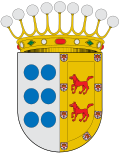Ana Francisca de Borja y Doria facts for kids
Quick facts for kids Ana Francisca de Borja y Doria |
|
|---|---|
| Countess of Lemos and Viceroy of Peru | |
| Reign | Viceroy of Peru: 1667 – 1672 |
| Spouse(s) | 1. ?-1663: Enrique Enriquez Pimentel, V Marquis of Tavara, Viceroy of Navarre and Viceroy of Aragon 2. 1664-1672: Pedro Antonio Fernández de Castro, X Count of Lemos, VII Marquis of Sarria, grandee of Spain, XXVII |
| Noble family | Borja or Borgia |
| Father | Francisco Pascual de Borja y Aragón and Centelles, VIII Duke of Gandia |
| Mother | Artemisa María Ana Teresa Gertrudis Doria Colonna, princesa de Doria de Melfi |
| Born | 1640 Gandia |
| Died | Madrid |
| Burial | Church of Santa Pedro, Madrid, Spain, called at that time, Church of St. Paul, Madrid, Spain |
Ana Francisca Hermenegilda de Borja y Doria, Countess of Lemos (1640–1706) was an important woman in the history of Peru. She was the wife of Pedro Antonio Fernández de Castro, who was the Viceroy of Peru. A viceroy was like a governor chosen by the King of Spain to rule a large area called a viceroyalty.
What makes Ana Francisca special is that she became the first female governor of the Viceroyalty of Peru. This happened when her husband, the Viceroy, had to leave the capital city for five months. She took over his duties and managed the government.
Contents
Early Life and Family
Ana was born in 1640 into the House of Borja, a very old and powerful family. She was related to Francisco de Borja y Aragón, who was also a viceroy of Peru many years before her. Both of them were descendants of Saint Francis Borgia.
Her father was Francisco Diego Pascual de Borja y Aragón y Centelles, the 8th Duke of Gandía. Her mother was Artemisa María Ana Teresa Gertrudis, a princess from the Doria family.
Marriage and Journey to Peru
On July 20, 1664, Ana married her cousin, Pedro Antonio Fernández de Castro. He was the 10th Count of Lemos. When they married, she became the Countess of Lemos.
On June 12, 1667, her husband was chosen to be the new Viceroy of Peru. This decision was made by Mariana of Austria, who was ruling Spain for her young son, Charles II of Spain.
The Count and Countess of Lemos arrived in Peru on November 9, 1667. They landed at the port of Callao. The Spanish people living in the colony welcomed them with a grand celebration. Her husband officially started his job as Viceroy on November 21, 1667.
First Female Governor
On June 7, 1668, Viceroy Pedro Antonio Fernández de Castro had to travel away from the capital. He sailed from Callao to other parts of Peru, like Islay, Arequipa, and Puno.
Before he left, he officially put his wife, Ana Francisca, in charge of the government. She became the gobernadora, or female governor, of Peru. This was a very important and official role. The royal rules for the viceroy's job said that if he was away, his wife would be in charge.
Ana Francisca was not just a symbol. She had real power and made important decisions for the colony. She held meetings with officials, like the Audiencia of Lima, on July 5, 1668. She issued decrees and managed the daily business of the government.
Facing Challenges
While she was governor, news arrived on August 31, 1668, about an attack. The English pirate Henry Morgan had attacked Portobelo in Panama on July 11.
Countess Lemos quickly responded to this threat. She sent supplies and military equipment to help the people defending Portobelo. She also prepared the colonial navy to protect the Peruvian coast from other pirates. During her time as governor, pirates did attack the port of Callao.
Her husband, the Viceroy, returned and took back his duties on November 12, 1668. Countess Lemos had been the governor of Peru for five months and five days.
Family and Saint Rose of Lima
Ana Francisca and her husband had two children before they came to Peru. They had three more children while living in Lima. Their fourth child, Rosa Francisca, was born on September 18, 1669. She was named after Blessed Rose of Lima.
The Countess had a lot of influence in the Spanish royal court. Because of this, she also had influence with the Pope. She continued the work of her uncle, Viceroy Francisco de Borja y Aragón. They both wanted to see Saint Rose of Lima become a saint.
Rose of Lima was declared "Blessed" on February 12, 1668. A big celebration was held on April 15 of that year. The news reached Lima on January 18, 1669.
The Count and Countess sent a sculpture of Saint Rose to the Vatican. A famous sculptor named Melchiorre Cafà made it. The Countess also paid to replace Rose's old wooden coffin with a new silver one.
On August 11, 1670, Rose was named the patron saint of all Spanish lands in the Americas and the Philippines. This was at the request of Spain's regent, Mariana of Austria. Rose of Lima and Francis Borgia were both made saints on April 12, 1671, by Pope Clement X. Rose was the first person born in the Americas to become a Catholic saint.
Later Life
Viceroy Count Lemos died on December 6, 1672. Countess Ana Francisca and her children left Peru on June 11, 1675. She passed away in 1706 in Madrid, Spain.
Images for kids
See also
 In Spanish: Ana Francisca de Borja y Doria para niños
In Spanish: Ana Francisca de Borja y Doria para niños





